#Zigbee devices serial solutions
Explore tagged Tumblr posts
Text
https://www.futureelectronics.com/p/semiconductors--wireless-rf--rf-modules-solutions--rfid/mlx90109edc-aaa-000-re-melexis-4229597
RFID Module, UHF Module, Proprietary RF Module, Rfid proprietary modules
MLX90109 Series 3.1 to 5.5 V 3 mA 125 kHz RFID Transceiver - SOIC-8
#Wireless & RF#RF Modules & Solutions RFID#MLX90109EDC-AAA-000-RE#Melexis#Bluetooth devices accessories#Zigbee devices serial solutions#Bluetooth Module#RFID Module#UHF Module#Rfid#Proprietary GPS modules#Uhf serial devices solutions
1 note
·
View note
Link
MultiTech MTR-LNA7-B07-US in Kit. 700MHz-850MHz 1.7GHz-1.9GHz 150Mbp Multi Connector Cell 100 Series Cellular Router.
1 note
·
View note
Text
Challenges in IoT Application Development
We've all heard a lot of time about how the Internet of Things application development is a game-changing force for business operations, software development, and industries in general. Customers are pleased, and businesses, according to all estimates, are expanding at a quicker rate than your waistline.
All investments are fetching fair returns in general. Besides, there are lots of happy customers resulting in faster business growth nowadays. As per experts, holidays are now sunny days for business growth everywhere.
Out of all these, something remains unsaid! It is that an IoT solution or software development is nothing short of a treasure trove. The need of the hour in the market includes high-quality, user-friendly, secure and strong solutions. To account for everything, IoT development teams must re-evaluate their regular procedures.
Because of the high demand, competition among start-ups and every IoT development company in India is at an all-time high. This, combined with the shortage of widely accepted standards, keeps programmers on the lookout for new techniques and regulations. Only a particular way of approaching every aspect of IoT software development will yield effective development.
Here, we are going to discuss some of the primary challenges in IoT applications that project developers experience often:
Selecting the apt operating system
There are quite a few technical aspects that must be considered before beginning an IoT application development process. First and foremost, the team must assess the IoT devices with which they will collaborate. Unlike traditional desktop computers, IoT devices are pretty weak and don't have an unlimited memory capacity. As a result, the developers must select the appropriate operating system. Besides, it should be compatible with the device's capabilities and the need for its proper functionality.
Determining proper gateways
When it comes to IoT solution gateways, they're the glue that holds everything together. Different devices support various connectivity protocols, such as Zigbee, serial ports, Wi-Fi, Bluetooth, and different energy profiles. Because gateways connect previously linked clouds, IoT sensors, and devices, they are critical to the IoT ecosystem as a whole.
Some standard mandatory features found in modern and advanced gateways from Nexcom, Intel, and Dell technologies, along with several other top providers, make developers' lives easier. All you have to do now is choose one that is most suitable for your IoT application needs.
You'll need to think about the network specifications and interface, as well as the development environment, memory capacities, and power rating, and more. By default, devices must be able to communicate in a secure, private, and trustworthy manner.
Choosing the correct IoT platform
None of the programmers wants to start an IoT application development process from the ground up. What's the point of reinventing the wheel? That is when an IoT platform seems the most useful, as they provide a set of tools for connecting all physical objects to the internet. Make sure you choose wisely because a platform market is vast and confusing. A platform that you finally select should include the following features:
Connectivity
Ease of Integration
Scalability
Security
Usability
However, IoT developers must keep in mind that platforms ideal for modern factories may not be suitable for energy consumption or cars. Some businesses set up real-world testbeds using real information from the manufacturing process to determine the best platform.
The strength of the security level
Because IoT technology incorporates a large number of connected devices, hackers have a large number of promising targets to find out vulnerabilities. Moreover, not every device that makes up a network is always thoroughly tested for security vulnerabilities. And now you find yourself in a situation where the complete system is in jeopardy.
Experts predict that by 2020, IoT will account for 25% of total detected enterprise attacks, even though only 10% of IT security budgets will be dedicated to protecting systems from these attacks.
Security is one of the significant challenges in IoT applications as the number of cyberattacks continues to rise. You can determine the protection level by analysing how much an IoT Development Company in India is willing to invest in hiring security experts. Moreover, this should occur right at the beginning to minimise unauthorised access and unwanted attacks. For that, companies may also use:
TLS/SSL encryption techniques
Vetted frameworks for website design and development
Isolated VLA
Machine-to-machine and end-user authentication
Detached business VPN
Updated and modern anti-virus
Traditional protection and control methodologies in enterprise security architecture should have been updated by yesterday to meet the new challenges of IoT today. You've been given a fair warning.
Quality control
Quality assurance is yet another weak factor for IoT application development. Since insulin pumps and temperature control for warehouses both require IoT devices, the testing process must be at par always. Besides, even the smallest of problems, in this case, can pose to be fatal if the quality control is not done correctly.
It is always better to incorporate the factor of security testing during the process of software development right from the beginning. To optimize the whole process, you can start by finding modules that won't require thorough testing during every release. You can also find those protocols that have already passed the security testing stages and will remain intact until the upcoming few releases.
Apart from security testing, compatibility and usability must also be well-assured. Providing technical support post project delivery is always a wise decision too.
Fixing a user-friendly design
Every IoT application that is being developed for consumers must be design-driven and straightforward to the maximum level. For example, no one ever wants to read an entire manual to fix problems in their smartwatch. Moreover, a user-friendly device is also suitable for all industrial start-ups since there is a requirement for quick decision-making and data visualisation. Overall, there should always be proper coordination between IoT designers and developers.
Takeaway
Although there has been considerable growth of IoT application development processes over the years, there is still room for problem-solving. Therefore, it is finally time for every IoT development company in India to determine the problem areas and find solutions for them.
NTSPL, a leading IoT App Development Company in Bhubaneswar, India, helps businesses create next-generation IoT apps. These applications add value to your company by increasing productivity, accuracy, and cost savings of up to 50%.
It enables more direct interaction between the dynamic world and computer-based systems, resulting in enhanced efficiency, accuracy, and cost savings. NTSPL offers outstanding Internet of Things (IoT) solutions and services, allowing organisations to reap the full benefits of IoT technology.
The experts at NTSPL evaluate and examine the software platform with vibrant solution architecture to create and improve IoT applications. IoT application development services assist in creating smart devices that are connected to the internet and share information.
#iot application development#iot application development company in india#challenges in iot applications#iot solution
0 notes
Text
IoT Sensors Market Analysis, Revenue, Price, Share, Growth Rate, Forecast 2028
Global IoT Sensors Market: Snapshot
IoT is a system that is implanted with sensors, connectivity to network, gadgets and programming empowering physical items to gather and trade the information. Sensors in IoT play an indispensable role in estimating the physical nature of items and list it into an esteem which is additionally perused by another gadget or client. IoT sensors allude to the sensors utilized in keen applications, which require network, constant analysis, and regular interfacing stage for gathering and breaking down information. It is a processing idea where each physical protest is associated with the web, and every such question can speak with one another.
Get Brochure of the Report @ https://www.tmrresearch.com/sample/sample?flag=B&rep_id=3846
The IoT sensor advertise is flourishing with different kinds of sensors associated with gadgets and individuals, which empowers a two-way correspondence process among man and machine. There are different end-utilize businesses where IoT sensors are sent to encourage this two way correspondence and for social event information. As IoT ascends to predominance, a sensor takes more dependable part, which generally, is intended to quantify a physical quality and list it into an esteem that can be perused by a client or another gadget. Yet, all sensors are not the equivalent and distinctive IoT applications require diverse kinds of sensors. For example, computerized sensors are direct and simple to interface with a microcontroller utilizing Serial Peripheral Interface (SPI) transport. In any case, for simple sensors, either simple to-advanced converter (ADC) or Sigma-Delta modulator is utilized to change over the information into SPI yield.
Developing interest for consumer gadgets, for example, cell phones, shrewd TV, and keen home machines connected with IOT, legislatures of the few developing nations are inflowing into various open and private joint efforts for the extension of its cloud benefits through its information and IoT focus advancements, developing IoT applications in the car and modern markets are a few elements, which are required to push interest for IOT sensors over the coming years.
Global IoT Sensors Market: Overview
The global internet of things (IoT) sensors market is anticipated to see expansion with the growing significance of real-time computing for IoT applications. The advent of internet protocol version 6 (IPv6) and higher demand for wearable and connected devices could push the growth of the market during the course of the forecast period 2018-2028. On the other hand, improved application of sensors in IoT devices due to technological developments, plummeting costs, and reduction in size is predicted to strongly support market growth. Rise in internet penetration and introduction of 3GPP Releases 13 and 14 specifications could also contribute to the market in a positive way.
Global IoT Sensors Market: Trends and Opportunities
There are different types of IoT sensors available on the market, viz. inertial, image, accelerometer, gyroscope, magnetometer, humidity, temperature, and pressure, which exhibit their own rates of demand depending on their requirement. However, amongst these, gyroscopes could show higher growth rate in the coming years. This could be due to the swelling demand for equipment optimized with sensors used in satellite positioning, navigation, and other applications. The demand for gyroscopes could increase on the back of the rising adoption of automation in a number of industries and the massive requirement of remotely operated vehicle guidance.
Amongst network technologies, wireless is expected to gain a whole lot of traction in the global IoT sensors market. There is a strong requirement of more robust internet connection created with the swelling demand for wireless data from smart grids, connected cars, and mobile devices. The adoption of wireless network technology is projected to increase while riding on lower installation and maintenance costs and the rising adoption of cloud platforms.
Global IoT Sensors Market: Market Potential
Leading equipment breakdown and technology insurer, Hartford Steam Boiler (HSB) has announced its next-gen IoT sensors and software to connect facilities and equipment via IoT. The sensors use proprietary algorithms to improve performance and avoid loss and are delivered to commercial customers in a simple kit. The HSB Sensor Systems service provides all the software and hardware required to issue alerts when changes suggest trouble, analyze data, and monitor conditions 24/7. It acts as an early warning system for religious groups, schools, building owners, and other entities.
Low-power wide-area networks wireless technology, LoRaWAN is used in the new set of HSB sensors. It can communicate through building floors and walls and offers extended range to connect dispersed facilities and equipment. Instead of Wi-Fi systems, the technology makes use of cellular systems.
Global IoT Sensors Market: Regional Analysis
On the geographical front, the global IoT sensors market is foreseen to witness the rise of North America in the foreseeable future. In 2018, the region held a stronger share of the market. The growth of the regional market could stem from the increasing adoption of wireless sensors in consumer electronics, oil and gas, healthcare, automotive and transportation, and industrial sectors and industries.
North America could be overtaken by Asia Pacific by the end of the forecast tenure while growing at a higher CAGR. Factors such as enhanced IT infrastructure, improving disposable income, wide consumer base, and increasing internet penetration in residential as well as commercial spaces are envisaged to support the growth of the market in Asia Pacific.
Global IoT Sensors Market: Companies Mentioned
The global IoT sensors market marks the presence of top players such as STMicroelectronics, NXP Semiconductors, Broadcom, TE Connectivity, and Texas Instruments.
Global IoT Sensors Market: Sensor
Temperature Sensors
Pressure Sensors
Humidity Sensors
Flow Sensors
Accelerometers
Magnetometers
Gyroscopes
Inertial Sensors
Image Sensors
Touch Sensors
Proximity Sensors
Acoustic Sensors
Motion Sensors
Occupancy Sensors
Co2 Sensors
Light Sensors and Radar Sensors
Image Processing Occupancy Sensors (IPOS)
Intelligent Occupancy Sensors (IOS)
To get Incredible Discounts on this Premium Report, Click Here @ https://www.tmrresearch.com/sample/sample?flag=D&rep_id=3846
Global IoT Sensors Market: Network Technology
Wired
Wireless
KNX
LonWorks
Ethernet
Modbus
Digital Addressable Lighting Interface (DALI)
Wi-Fi
Bluetooth
Zigbee
Z-Wave
NFC
RFID
EnOcean
Thread
6LoWPAN
WirelessHART
Process Field Bus (PROFIBUS)
DECT ULE
ANT+, ISA100, GPS, Sub-Gig, and Cellular
Bluetooth Smart
Wi-Fi/Bluetooth Smart
Bluetooth Smart/Ant+
Bluetooth 5
Global IoT Sensors Market: Vertical
Consumer
Commercial
Industrial
Home Automation
Smart City
Wearable Electronics
Consumer Devices
Consumer Appliances
Smart TVs
Smart Locks
Smoke Detectors
Home Theater Projectors
Next-Gen Gaming Consoles
Set-Top Boxes
Smart Washing Machines
Smart Dryers
Smart Refrigerators
Smart Ovens
Smart Cooktops
Smart Cookers
Smart Deep Freezers
Smart Dishwashers
Smart Coffee Makers
Smart Kettles
Traffic Management
Water Management
Waste Management
Smart Parking
Smart Lighting
Consumer Application
Healthcare Application
Industrial Application
Retail
Aerospace and Defense
Logistics and Supply Chain
Entertainment
Financial Institutes
Corporate Offices
Advertising and Marketing
Digital Signage
Energy Optimization
Intelligent Payment Solution
Real-time/Streaming Analytics
Resource Management
Safety and Security
Smart Shelf and Smart Doors
Smart Vending Machine
Drones/Unmanned Aerial Vehicle (UAV)
Predictive Maintenance
Energy
Industrial Automation
Transportation
Modes of Transportation
Types of Transportation Application
Healthcare
Smart Agriculture
Roadways
Railways
Airways
Maritime
Predictive Analysis
Telematics
Infotainment
Advanced Driver Assistance System (ADAS)
In-Vehicle (In-V)
Vehicle-To-Vehicle (V2V)
Vehicle-To-Infrastructure (V2I)
Telemedicine
Clinical Operations and Workflow Management
Connected Imaging
Inpatient Monitoring
Medication Management
Precision Farming
Livestock Monitoring
Fish Farming
Smart Greenhouse
Global IoT Sensors Market: Region
North America
Europe
Asia Pacific (APAC)
Rest of the World
U.S.
Canada
Mexico
Germany
U.K.
France
Italy
Spain
Rest of Europe
China
Japan
South Korea
India
Australia
Rest of APAC
Middle East and Africa
South America
Request TOC of the Report @https://www.tmrresearch.com/sample/sample?flag=T&rep_id=3846
About TMR Research:
TMR Research is a premier provider of customized market research and consulting services to business entities keen on succeeding in today’s supercharged economic climate. Armed with an experienced, dedicated, and dynamic team of analysts, we are redefining the way our clients’ conduct business by providing them with authoritative and trusted research studies in tune with the latest methodologies and market trends.
0 notes
Text
Sending-Data-of-IOT-Wireless-Temperature-and-Humidity-Sensor-to-MySQL
We are using here NCD’s Temperature and Humidity sensor, but the steps stay the equal for any of the NCD product, so if you have other NCD wireless sensors, experience free to observe alongside besides. By means of the stop of this text, you need to have a stable understanding of how to set up the sensors, configure node-red, and see the data on a dashboard like the one pictured right here.

IoT Long Range Wireless Temperature and Humidity Sensor
Introducing NCD’s long-range wireless temperature humidity sensor, boasting up to a 28 Mile range using a wireless mesh networking architecture. Incorporating the Honeywell HIH9130 temperature humidity sensor transmits highly accurate temperature and humidity samples at user-defined intervals.
The on-board temperature sensor is rated for -25°C to 85°C or -13°F to 185°F and the humidity sensor is rated for 0 to 100% RH. It can be powered by just 2 AA batteries and an operational lifetime of 500,000 wireless transmissions. Battery life can be extended up to 10 years depending on environmental conditions and the data transmission interval. Optionally, this sensor may be externally powered.
With an open communication protocol, this IoT wireless temperature humidity product can be integrated with just about any control system or gateway. Data can be transmitted to a PC, a Raspberry Pi, to Microsoft Azure® IoT, or Arduino. Sensor parameters and wireless transmission settings can be changed on the go using the open communication protocol providing maximum configurability depending on the intended application.
The long-range, price, accuracy, battery life and security features of Long Range Wireless Temperature Humidity Sensor make it an affordable choice which exceeds the requirements for most of the industrial as well as consumer market applications.

Long-Range Wireless Mesh Modem with USB Interface
Zigmo Wireless Communication Mesh Networking is simply the hottest wireless technology of our time period. It’s fast, it’s very easy to use, highly reliable, and self-healing. Three components are required for the ZigBee Mesh Network, the Coordinator ©, the Router (R) and the Endpoint (E). Your computer can speak to a ZigBee Mesh Network using a Coordinator. Think of the Coordinator as the interface to a Wireless Mesh Network. NCD Coordinators are equipped with a USB Interface. This Zigmo mounts as a Serial Port on your computer, and you will develop software that sends Serial commands at 115.2K Baud. The primary job of a router is to bridge the wireless gap between your computer (the Coordinator) and the device (Endpoint). If the Coordinator cannot speak to the Endpoint device because it is out of range, a Router can be used to bridge the two devices together. Endpoints are simply devices. With regard to NCD products, Endpoints can be relay controllers, data collection devices, PWM devices, and much more.

Resources Required
IoT Long Range Wireless Temperature Humidity Sensor with power source Battery Or External DC.
Zigmo/Router for PC
XAMPP
PC/Laptop with an OS installed or Any IoT Embedded Device.
Setting up XAMPP
XAMPP is most prevailing, free an open-source cross-platform which is one solution to run your web services. XAMPP is developed by ApacheFriends which released in May 2002. XAMPP Stands for Cross-Platform(X), Apache(A), MySQL(M) also Sometimes (M) refers to MariaDB, PHP(P) and Pearl(P).
XAMPP allows you to work on a local server and test local copies of websites using PHP code and MySQL databases. Once XAMPP is active, you can access your local copy with a browser using an URL like http://localhost/ or http://127.0.0.1/
Downloading and Installing XAMPP
Go to XAMPP web site and download the installer based on your operating system. Installation should be similar to a normal software installation you do in your operating system.
When installing, there would be an option to select whether you want to run Apache and MySQL as services. If you chose it, Apache and MySQL will start at system boot-up which may not need if your computer is tight with memory resources or if you are not doing PHP development frequently. You can change these settings after installation.
Starting Apache and MySQL
Go to the location where you installed XAMPP (usually C:\Program Files\xampp) and double click on XAMPP Control Panel (xampp-control.exe). This will bring you the following screen. Click on Start buttons next to Apache and MySQL for starting them.
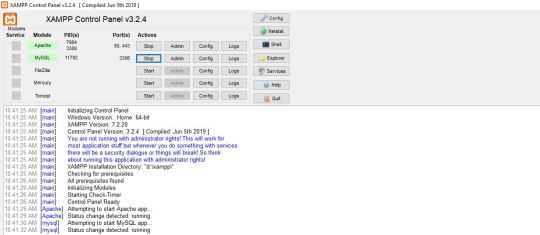
Now open up your browser and type http://localhost/ or http://127.0.0.1/
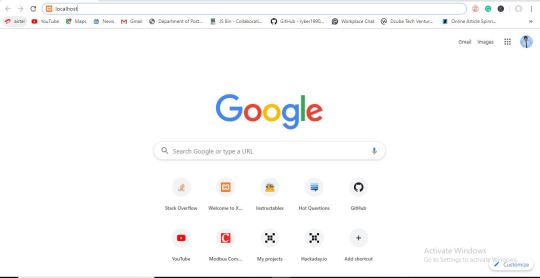
This will open up the following page. Click on the phpMyAdmin.

This will bring you the following screen. Now click on the “New” button as shown in the picture below to create a new database.
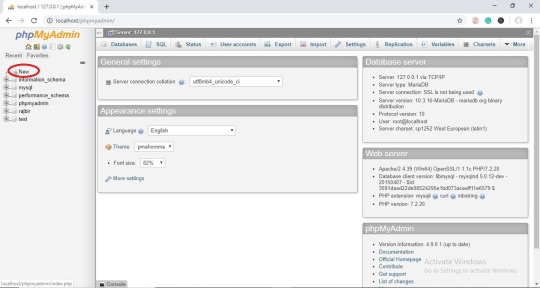
Now create a new database as shown in the picture below.
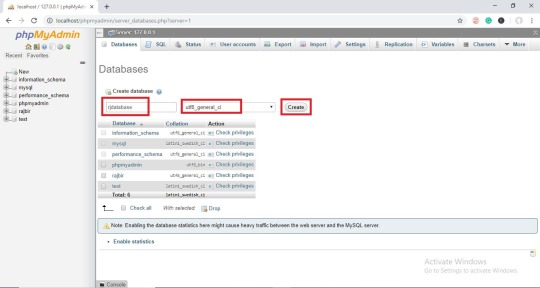
Now create a table to visualize data as shown in the picture below.
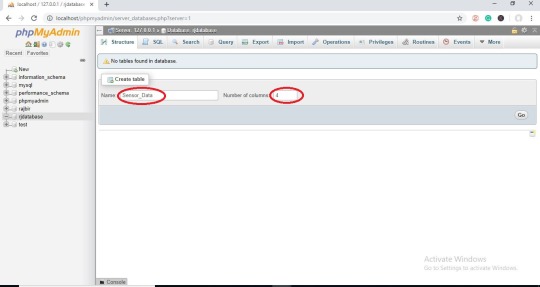
Now name the first column as “id”.
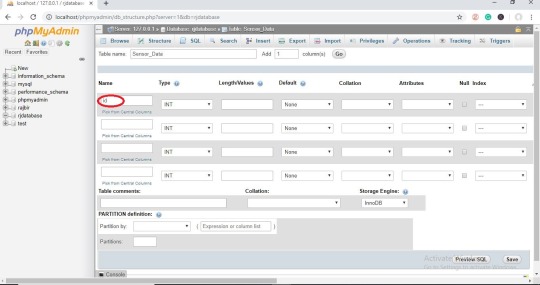
Now scroll to the right side of the screen you will see “A_I Comments” i.e. Auto Increments and it is used setting primary key which uniquely identifies each record within the table. Click on the checkbox below it.
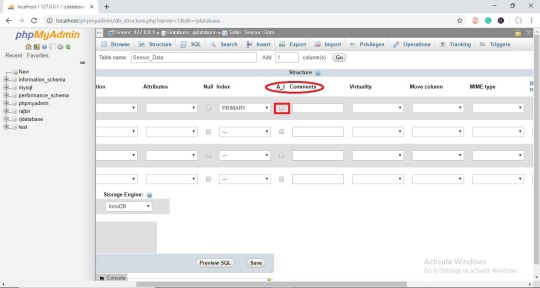
This will bring you the following screen. Now click on the “Go” button.
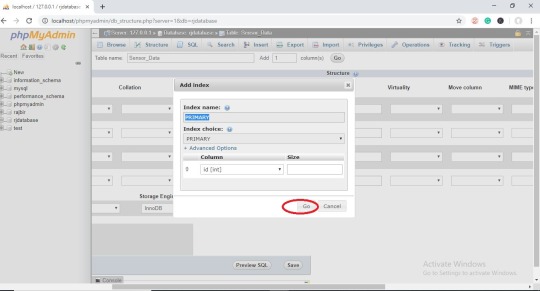
Now enter the values of other three columns Name = temperature, Type = DECIMAL, Length/Values = 10,2(i.e up to 2 decimal points) and similarly for humidity and in the last column you can show created time and click on the save button as shown in the picture below.
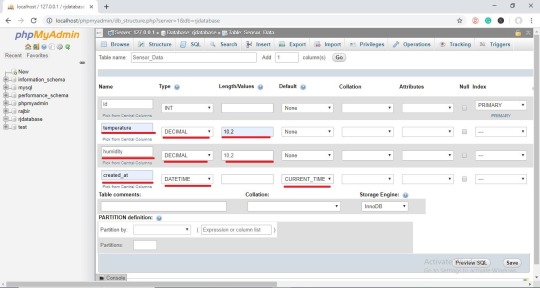
Now click on your database name to expand it and it will show your table name, then click on it to view how data is shown, as shown in the picture below.
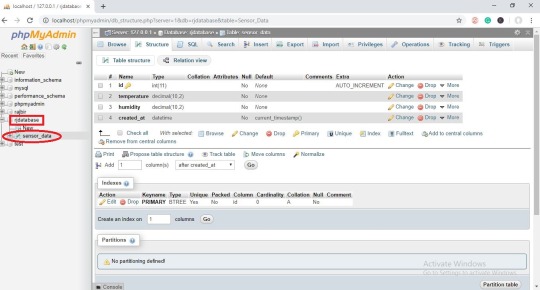
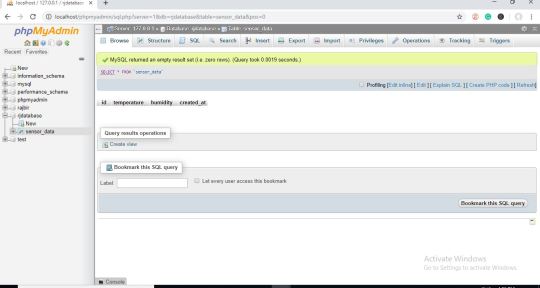
That’s all with the setting up of XAMPP.
Setting up Node-Red.
The sensor and Zigmo/Router come pre-programmed and work out of the box. In this section, we will set up a sensor and Zigmo link and start receiving data on our PC.
Steps to install NODE-RED
Now that you have sensors running, we need a way to do something useful with that data.
First of all, you’ll have to install Node-RED.
Once that’s done, you’ll need to enter your command line, or Power Shell for Windows users, navigate to the directory Node-RED is installed in.
Now type “npm i ncd-red-wireless node-red-dashboard“. This will install the nodes required to receive data from your wireless sensors and you can start Node-RED once this is done.
To start node server write node-red in the command prompt or terminal and press enter.
Setting up the nodes
Assuming at this point you’ve started up Node-RED, you should be able to open a browser and navigate to http://localhost:1880, this will open up the flow builder that is the heart of the Node-RED experience.
Steps to build the flow
At this point you’ll be viewing a large blank flow with a long list of nodes on the left-hand side, this sidebar is called the palette.
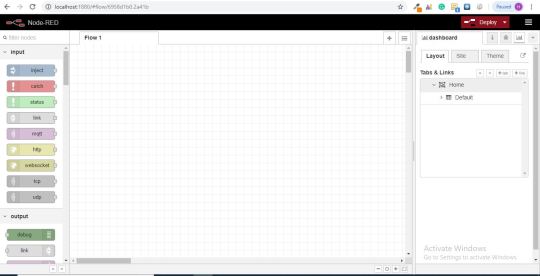
Go ahead and drag a Wireless Gateway node over to your flow canvas to get started.
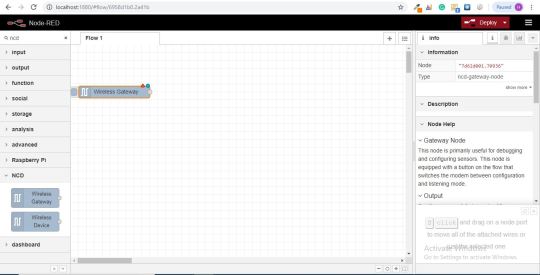
ncd-red-wireless Provides the nodes that manage the serial connection, parse incoming sensor data, filter it by specific parameters, and allow you to configure the wireless sensors.
Finding your wireless sensors
Once you’ve added the node you’ll be able to view the info tab, which contains information about the node’s functionality, this tab is well-populated for most node-red packages and contains valuable information, many times you will not need to view any other documentation outside of the info tab, so keep it in mind while you are building your flows if you have a question about how a node works. The next thing we need to do is configure the node, when you first add it you’ll notice that there is a small triangle on the top right corner next to a blue dot, the triangle indicates that the node needs additional configuration, the blue dot indicates that the node has not yet been deployed as part of the flow.
Double click on the node to open up the configuration options.
Click on the pencil icon next to the Serial Device field to configure your USB router, this will open a second configuration panel that only has a few options.
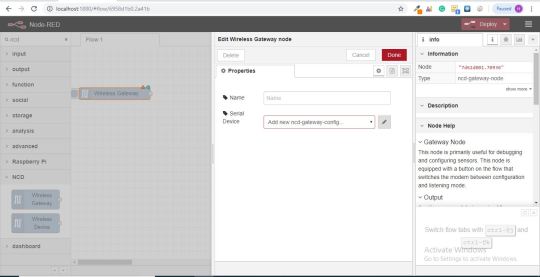
Click on the magnifying glass next to the Serial Port field and select the port that corresponds with your router, then click the “Add” button on top.
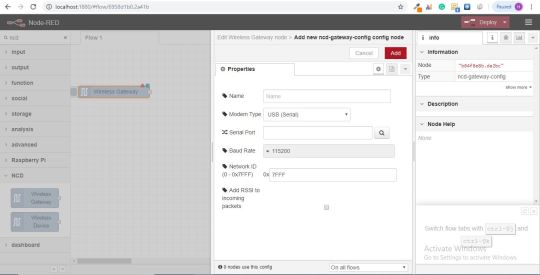
The Serial Device field will now be populated based on that selection, and you can click “Done”, you now have direct access to your wireless sensors! To view the data coming in.
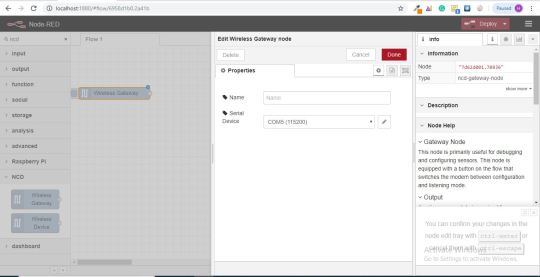
Now go back to your palette and type “debug” into the search field at the top, grab one of these nodes and drag it to the right of your Wireless Gateway.
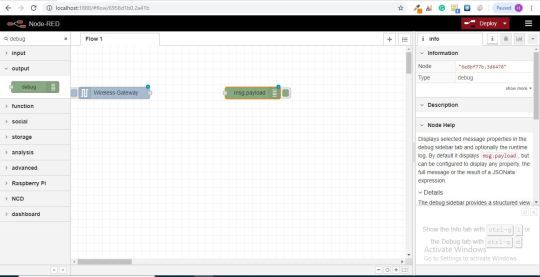
Double click on it and change “msg.” to “complete msg object” click done.
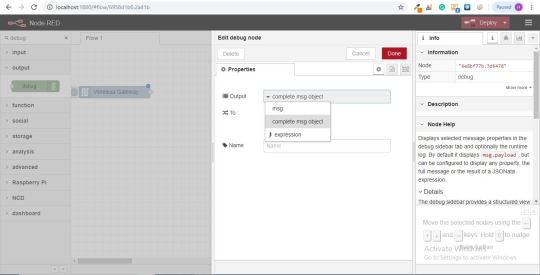
Now draw a line between the two nodes, and click “Deploy” on the top right of the window...
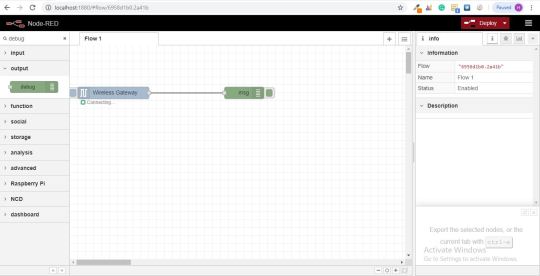
Working with the data
Now out of your wireless sensors data is gathered and it is output to the “debug” tab, this “debug tab” is placed within the right sidebar subsequent to the information tab. To see the information are available in to hit the reset button. In node-red records is surpassed among nodes in a JSON packet. When the msg object comes into the debug tab you may make bigger it to view the overall list of information that comes with it. This is extraordinarily useful in case you need to quickly see which sensors are checking in. The other issue this node gives is an easy way to interchange your router to the network identity that devices in configuration mode document on, simply hit the button on the left of the node and the tool will switch to the configuration network, hit it once more to return it to listening mode. Once we get the wi-fi tool nodes set up, they may be set to routinely configure a sensor whilst it enters configuration mode, so it’s always available to maintain such gateway nodes present at the flow for speedy configuring a device.

Adding the wireless sensors
we need to separate wireless sensor records domestically in order that we are able to display it, we could use a switch node to split out the messages from the gateway based totally on the mac address with or sensor type, but as I referred to, the wireless nodes truly incorporate extra functionality for configuring the sensors, so we’ll start with them to give you an extra entire image of how those structures can work. In case you haven’t already seen packets coming in from both of your sensors, cross in advance and hit the reset button on the only that hasn’t stated. While a sensor assessment in thru any serial device configuration node, the mac address and kind of sensor is cached in a pool so we are able to quickly find it for the duration of this next step.
Grab a Wireless Node from the palette and drag it onto the flow, double click on it to get it configured.
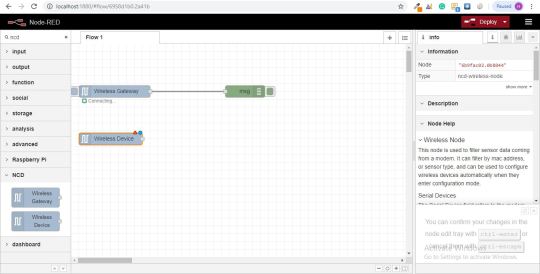
Select the serial device from the drop-down that you used for the Wireless Gateway, now click the magnifying glass next to “Mac Address” and select one of the available options.
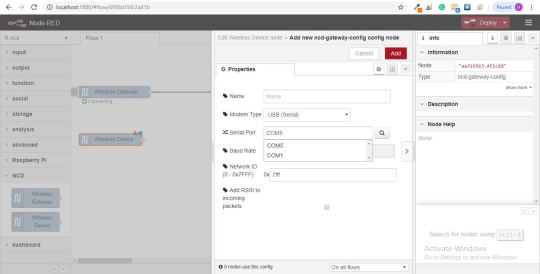
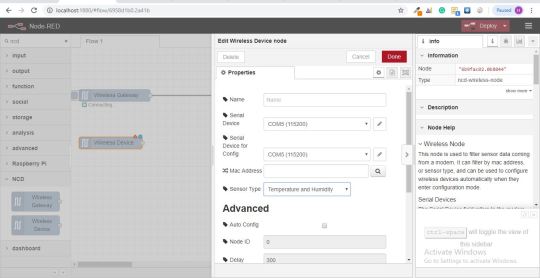
You’ll notice this automatically sets the sensor type for you, you can also give it a name to make it easier to identify. As noted in the info tab, the Serial Device for Config field is optional, and we won’t worry about it right now. The node you have just added effectively works as a filter on incoming sensor data, only passing through data for the mac address, or sensor type if no mac address is present.
Now go back to your palette and type “debug” into the search field at the top, grab one of these nodes and drag it to the right of your Wireless Gateway.
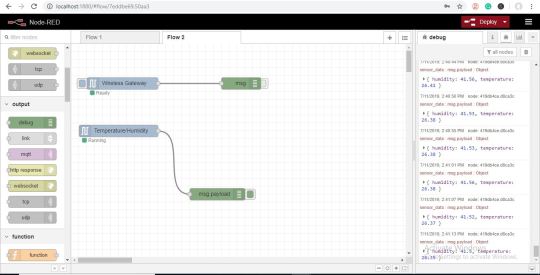
Double click on it and click done
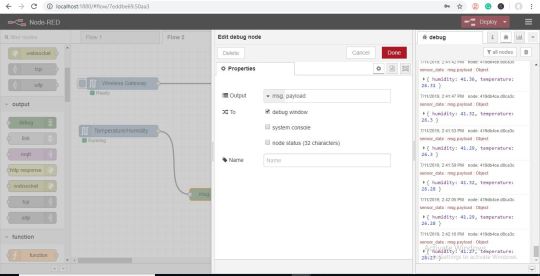
Adding Function Nodes
The function node is used to run JavaScript code against the msg object. The function node accepts a msg object as input and can return 0 or more message objects as output. This message object must have a payload property (msg.payload) and usually has other properties depending on the proceeding nodes.
Now grab a “function” node from the palette, and place it to the right of the Temp/Hum node.
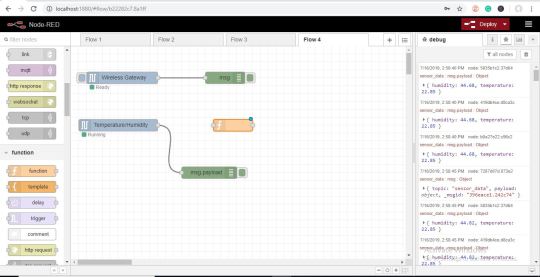
Double click on the node to open up the configuration options.

Here you have to write little javascript code to create a condition, so the data is sent to the MySQL database.
Now you have added “MySQL” node to store data, check your palette if it is present there or you can click on the three bars present right side of deploy button as shown in the picture below.
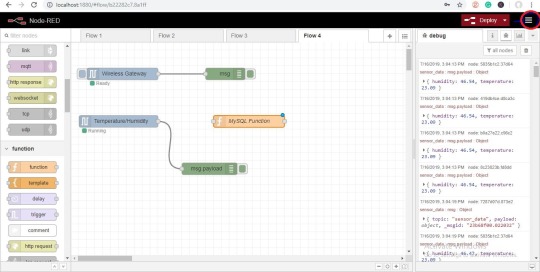
Now click on the “Manage palette” button.

Now search for mysql and click on the ‘install’ button as shown in the picture.
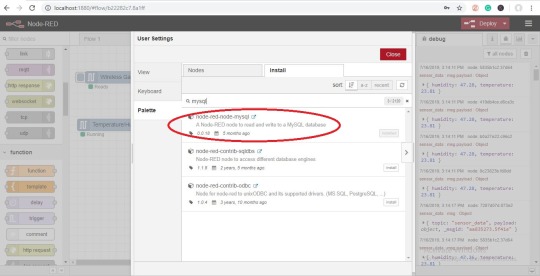
Once it is done, you’ll see “mysql” node is present in the palette.
Now grab the “mysql” node from the palette and double click on it to open up configuration options.

Write your database name as you created earlier and give a name to it, then click on the pencil icon next to the Database to edit the sqldatabase node.
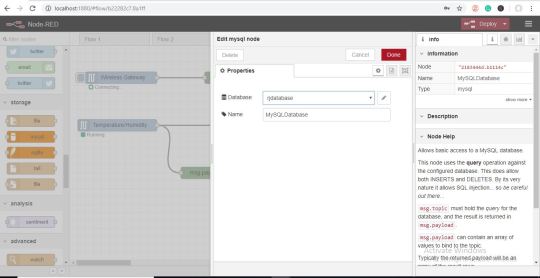
Now add User = root i.e by default in the xampp and password is blank. You can also create user and password enter that here, then enter your database name and time zone(optional) and then click update and done.
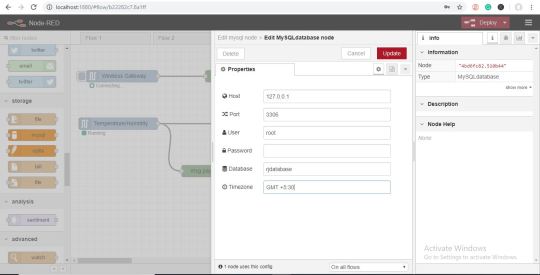
Now you’ll see your database node shows connected.
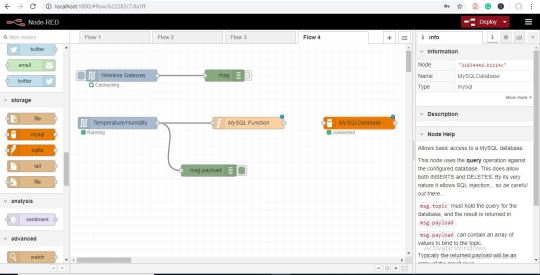
Now connect all the wires as shown in the picture.
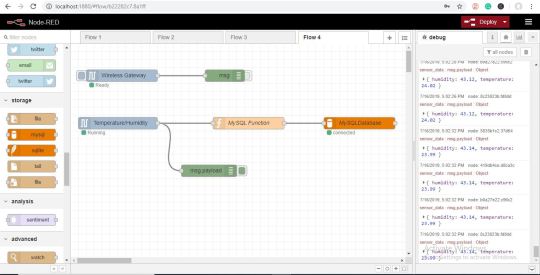
Now hit the deploy button and you’ll database node shows “ok”, its means data is sending.
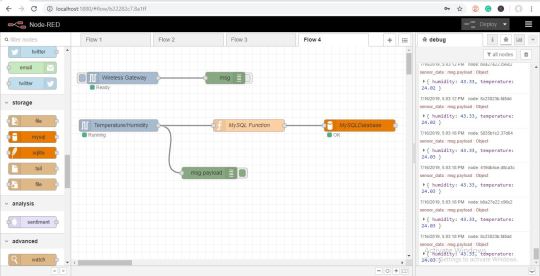
OUTPUT
Here you can visualize the data coming in.
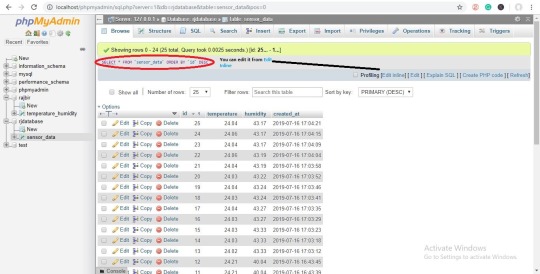
Node_Red_FLOW
https://github.com/ncdcommunity/Sending-Data-of-OT-Wireless-Temperature-and-Humidity-Sensor-to-MySQL/blob/master/node-red%20Sql_flow.json
0 notes
Text
TOP IOT Software Development Challenges in 2020
Internet of Things (IoT) transforms manufacturing, business processes and software development (choose from anything you like most here). Connected devices capture the market in all figures, generally provide good returns on investment, pleasing consumers and businesses grow rapidly.
Everything remains unbroken. The development of IoT software is a minefield these days. The market demands high-quality, scalable, reliable, secure and easy-to-use solutions. To take everything into account, IoT development teams need to reassess their standard procedures.

So here I am going to reveal the iot software development challenges.
1.Operating System Considerations
Many technological factors should be thoroughly examined before commencing the IoT application development. The team must first test IoT devices for which they will operate. IoT computers are much less efficient and have relatively small memory capacity, different from conventional desktops. This means the mobile app developers must choose the correct operating system. It should suit the device's capabilities as well as the design specifications.
Linux was the first option for IoT microcontrollers, confined tools, and gateways as per the IoT developer survey.
2.Selecting Gateways
When considering IoT gateways, they are crucial to linking all elements. Different devices can have different protocols of connectivity: Ethernet, Wi-Fi, serial ports, Zigbee. The gates between the connected devices, IoT sensors & the cloud. The entire IoT ecosystems rely on them.
Dell Technology, Intel, Nexcom and other leading providers deliver new smart gateways with some common mandatory features that make their lives easier than before. You simply have to pick one which meets the requirements for your IoT application. The interface and network requirements, the power rating, memory capacity, the development environment & other parameters must be taken into account. There should be guarantee secure, private and trustworthy communications between devices.
3.Right IOT Platform
IOT App Developers don't want to build the scratch-based software. Why the wheel to reinvent? That is why IoT platforms are useful because they provide a variety of tools to link the physical objects. There is a wide and confusing platform market, so make sure you choose wisely. Your favorite platform should provide
connectivity
protection
scalability
easy integration
usability
IoT developers should remember that smart devices may not suit connected vehicles or energy consumption solutions perfectly in smart factories. Some companies also decide on the correct platform by creating a real-world test with current data from the manufacturing process.
4.Security
IoT Technology contains numerous connected devices so that hackers can search for vulnerability with several favorable targets. Not all devices comprising a network have been tested for penetration adequately. The whole system is threatened here.
Gartner notes that by 2020 25% of all organization attacks reported would include IoT and that only 10% of its IT security budgets will be allocated to defend networks against such attacks.
There will still be a growing number of cyberattacks, and protection is a huge challenge for IoT developers. The level of protection depends largely on how ready the organization is to invest in security expertise at the very stage of the design.
5. Cross-Platform Deployment
The IoT Ecosystem consists of various architectures, protocols & operating systems. All of these variables will work seamlessly and match together. This has led to the creation of open standards and design templates for the use of cross-platforms by the Internet Technology Task Force (IETF), IEEE and other respectable organizations. The IoT services should use these best practices to ensure integrated communication and they are constantly updated.
Conclusion
The Internet of Things app development or software development has still had many problems to solve, despite the rise in IoT adoption from the past few years. Now, IoT companies and developers should be looking over information not previously taken into account.
If you are looking for the top IOT-Based Mobile App Development Company in Dubai and your efforts will reduce with the team of fusion informatics. We Fusion Informatics is the leading IOT Development Company and offering IOT Solutions to different clients across the globe.
For More Details
Mobile App Development Company in Saudi Arabia
Mobile App Development Company in Bangalore
Mobile App Development Company in India
Locations
Mobile App Development Company in Dubai
Mobile App Development Company in Bangalore
0 notes
Text
Top Biggest Challenges of IoT App Development 2019
The IoT app development continues to its swift and steady rise in the industries. The market requires robust, high-quality, scalable, secure and user-friendly solution and the IoT development teams must reevaluate their workflow and procedure to take everything into account. Here’s a list of development challenges for IoT project that you might be facing while developing IoT apps.
The IoT will change your organization and business more than your imagination. Connecting devices are capturing the market in all estimates and generate good revenue, customers are happy, and businesses are rapidly growing. IoT technology is improving the way of people lives but with we all know nothing is perfect in this world so, IoT has also some issues left to resolve, and R&D team is making improvements and in the forthcoming years it will be free from major issues.
IoT Issues Developers StumbleUpon:
The demand for IoT is worldwide, due to this the competitions between the IoT startups and well-established software company has begun. Everyone wants to be on top to provide their services out of the box, for this programmer constantly looking for new practices and updated protocols. Let’s have a look at what challenges programmer need to face to provide robust IoT app solution.
1. Operating System Considerations:
Before development of IoT apps, developers must be aware of the several factors which needs to be considered while developing IoT apps. Unlike traditional desktops, IoT apps have small memory capacity and less powerful. This means developers needs to select operating system according to the compatibility of the devices and the requirements for its functionality.
2. Choose the Right IoT Platform:
For every development, developers want to develop from the scratch. Why reinvents the things? That’s where IoT platforms come in handy since they offer a combination of tools to brings your physical objects online. The IoT platform are big and more complex, so make sure you choose wisely, your preferred platform should provide:
Usability
Easy Integration
Security
Connectivity
Scalability
3. Choosing Gateway:
Gateways are the key to connecting multiple devices. Several devices have different connectivity protocols: Bluetooth, Wi-Fi, serial ports, Zigbee and have various energy profiles. Gateways are located between the connected devices, IoT sensors and the cloud, so the entire ecosystem depends on them.
Modern intelligent gateways are commons from the top gateway providers giants that makes developer’s lives easier.
4. Total Control Over Quality:
Quality assurance is also the most important aspects in IoT. Since IoT devices is not only used for temperature control in ware houses but also for insulin pumps, testing should be done well.
Security testing in the software development process from the very beginning. To optimize the process, look for the modules that no need of testing with every release. Find the protocols that have already undergone security testing and will remain unchanged for the next few releases.
5. User-Friendly Design:
Consumer IoT design must be simpler as possible, as nobody interested to read the manual to update the smart watch. User friendly design is also important for IoT start-ups as they should focus on data visualization and fast decision making.
Bottom Line:
Despite IoT technology is growing quickly, the internet of things development has yet to resolve few issues. Particularly, we now improve the security of IoT apps and their cross-platform deployment. However, since IoT is a relatively new field, the standards are still a work in progress.
This blog has been taken from the resource- http://bit.ly/2vAE3h2
0 notes
Text
Early Heart attack & Stroke Detection for Telecommunication
P. Leijdekkers , V. Gay (2007)
A Self-test to Detect a Heart Attack Using a Mobile Phone and Wearable Sensors.
- the patient ask simple questions about her health like if the patient feel pain etc. if the answers indicate low risk then the application ask to carry two ECG signal to analyse the sgns of a myocardial infraction (MI).
Jiang J, Yan Z, Shi J,Kandachar P. (2008).
Design of Wireless Mobile Monitoring of Blood Pressure for Undeserved in China by Using Short Messaging Service
– by using this proposed system, the BP measurements are delivered to server automatically eight time per day. The doctors in CHC/P can observe the data from the server and get analysis result. If desired, a feedback will be sent to the terminal unit (patients) through SMS when the bP levels raises to unacceptable levels.
S.S Kohli, A. Kaur, A. Singla, A. Laddi (2015).
Intelligent Remote Vital Health Parameter Monitoring System.
- the hardware and software modules used in this study were the sensor unit, wireless sensr network (WSN), control unit and central server. The vital parameter acquisition sensors and the control unit was installed over the patient's body at the marked points. The data acquired by the sensors was serially transmitted to the microcontroller. The microcontroller synchronizes the data before sending it to the WSN. Start and Stop bits were added to make the data frame so that data from each sensor could be received separately without any interference with each other. Data was transmitted in form of packets over the WSN from the patient node, router and finally to the coordinator. Before receiving, synchronization of the frames were checked. If due to any reason a bit is lost from the particular frame then that frame is discarded as that may contain false data. The wireless technolog has the potential to take the development in medical field to a great level by providing low cost and efficient solutins which would hel in enhancing the quality of life. The proposed work is in the direction to monitor the vital physiological parameters such as temperature, SP02, position, and respiration rate continuously and transmit it wirelessly through Zigbee standard from a remote area to the base station.
J. Wannenburg and R. Malekian (2015).
Body sensor network for mobile health monitoring, a diagnosis and anticipating system.
- The system is broken down into 3 subsystems. Subsystem 1 consist of the sensor used in the BSN, it contains the sensor that measure each of the physiological parameters specified and this is largely focused on analog front end and the acquisition of the measured signals. Subsystem 2 consist of the processing and communication unit explains the microcontroller aspect of the BSN. And the last system which provides the patient with biofeedback through notifications any abnormalities found are extracted here and sent to a medical doctor to allow for monitoring of the patient. The solution does not only focus on the specifications but also aspects to ensure that the design is practical and that the improvements to the system could be made as discussed on order to improve this solution so that it is capable of measuring the required vital signs independent of most external influences. The overall hardware design is definitely a strong point of the system and was implemented well.
[5] K. Jadhav, U. Chaskar (2017). Design and development of smart phone based ECG monitoring system. http://ieeexplore.ieee.org/stamp/stamp.jsp?tp=&arnumber=8256862
- consist of 6 stages: signal acquisition, signal amplification, signal filtering, signal processing, voltage booster and regulator, display the EKG signals and store the recorded data. ECG achieved successfully on windows application by using audio jack interfacing without any micro controller for communication. Much noise.
A. Goyal, S. Mittal, R. Sawant, A. Gidhwani, J. Bagate (2017)
Portable Heart Attack Detector.
-the proposed system aims to automatic detection of heart attack by constantly analysing the continuous ECG signal obtained from the body of the user.
R.B. Lagido, J. Lobo, S. Leite, C. Sousa, L. Ferreira, J. Silva-Cardoso (2017).
Using the smartphone camera to monitor heart rate and rhythm in heart failure patients.
-the methods used include signal acquisition, data validation, signal processing, and evaluation. The paper proved to be a feasible approach to the identification of atrial fibrillation in HF patients, through a mobile and reliable device that patients can easily use to monitor their own heart rate.
L. Shih-Hao Liou, W. Yi-Heng, S. Yi_Shun, G. Yi-Lan, C. Hung-Chin, P. Shing-Tai (2017).
Real-Time Remote ECG Signal Monitor and Emergency Warning/Positioning System on Cellular Phone
- uses HMM model in the system. The system allows when emergent accidence happened, that the ambulance can use the global positioning system in a cellular phone to receive timely recue.
D. Selvathi, V. Vishnu Sankar, H. Venkatasubramani (2017)
EMBEDDED BASED AUTOMATIC HEART ATTACK DETECTOR AND INTIMATOR.
-consists three modules; heart beat sensor, microcontroller section, GSM section. It provides 100% accurate results in detecting the attack with the help of sensor. Purpose of to provide a cost effective product for detection and intimation.
W. Chung-Min, C. Shih-Chung, C. Yeou-Jiunn (2018).
A multiple bio-signal measurement analysis and warning system for the long-term health care of severe disabled.
- This study successful create a multiple bio-signal measurement and analysis system that can provide information of vital parameters, such as HR, HRV, SPO2, BP and so on. In this study, the parameters of ECG can monitor the life activity, avoided the myocardial infarction, and PPG detect hypoxia to avoid organ damage, so which can effectively prevent the unexpected situations and danger.
Quotations from each literature
1. Body Sensor Network for Mobile Health Monitoring, a Diagnosis and Anticipating System
“Mobile health monitoring systems are capable of detecting a medical emergency and could prevent it by reporting it to medical services or by providing the user with biofeedback as an early warning; all achievable due to the implementation of continuous monitoring.”
Today’s generation, smartphones are the fastest spreading technology. People used smartphones in everyday life. It’s good to develop an application to detect your own health without going to the hospital for check-ups. If I build an application to detect early heart attack then I can be able to help people or I can save lives. Smartphones have the capability to detect medical emergency and able to prevent it through the use of microcontrollers and sensor. The development of such systems offer flexibility and cost saving options for both healthcare professionals and patients through the implementation of continuous health monitoring. It can monitor patients in rehabilitation and the elderly in assisted living, even patients having chronic diseases.
2. Portable Heart Attack Detector
The proposed system is divided into 3 parts. The third part is having, “the GPS module describes the location of the patient under observation and if the signal is abnormal then the GSM module sends an SMS along with the location coordinates to the doctor or listed emergency contacts for further precautions.”
GPS module is very helpful of my study for it will detect the location of the patient. Locating the current location of the patient plays a big role in my study. If the patient is having a hard attack, the system will automatically call the emergency then the emergency services will easy to detect the location of the patient. It can save time and save life as fast as it can.
3. Real-Time Remote ECG Signal Monitor and Emergency Warning/Positioning System on Cellular Phone
“An electrocardiogram (ECG) signal is the manifestation of the myocardium electrical activity on the body surface, which appears as a nearly periodic signal”
I will use ECG signal to monitor small electrical changes happen to the patient’s body arising from the activities of the human heart. It allows to measure easily of a variety of heart diseases.
4. EMBEDDED BASED AUTOMATIC HEART ATTACK DETECTOR AND INTIMATOR
“Observation in an electrocardiogram (ECG) waveform can detect the symptoms of heart attack. An ECG is an electrical recording of the heart and significantly help in the investigation of heart disease.”
I need ECG waveform to my proposed system to measure the heartbeat of the patient. To measure the electrical measures of the electrical hear beat it need to use the ECG waveforms. Each heartbeat, there is an electrical impulse or waves that travels through the heart. This wave causes the muscle to squeeze and pump blood from the heart. A normal heartbeat on ECG will show the timing of the top and lower chambers.
5. A Self-test to Detect a Heart Attack Using a Mobile Phone and Wearable Sensors
“If a person decides to do the self-test, it usually means she/he feels something. The first priority is to ask whether the person has heart attack related symptoms and analyse the answers.”
It is important to ask questions about what patient feels. It will help the patient to be aware of what happens to his/her body. I want to make my system a user friendly, able to interact with the patient through asking questions of what he feels so that the system will able to help the patient quickly, and give accurate advice or feedback to the patient anytime, anywhere without asking professional doctors or going to the hospital. It will make less hassle to the patients.
7. Design of Wireless Mobile Monitoring of Blood Pressure for Underserved in China by Using Short Messaging Service
“By using this system, the BP-measurements are delivered to a server automatically eight times a day. The doctors in CHC/P can observe data from server and get an analysis result (BP trend analysis) for every patient through a software specially developed for this purpose.”
- It is important that the doctor will monitor their patient all the time. If there is abnormalities happened to the patient, the doctor can easily help its patient. Because BP-measurements are delivered to a server automatically eight time a day, the doctor will keep track of the health of the patient. And if desired, a feedback will be sent to the patient through SMS when the BP level raises to unacceptable levels.
8. Intelligent Remote Vital Health Parameter Monitoring System
“Patient needs to wear all the sensors on the body and the data transmission and processing was done at the receiver's end.”
In my study, patient requires to wear all the sensor needed to monitor their health. Sensors will measure the heartbeat, pulse rate and temperature of patients. Then the data gathered from the patient will pass to the receivers that will analyze the result from the data.
9. Using the smartphone camera to monitor heart rate and rhythm in heart failure patients.
“ECG measurements were performed by a health professional who provided the ECG report as reference for analysis.”
Electrocardiogram is used to detect abnormal heart rhythms and to investigate the cause of chest pains or abnormalities that health professionals are the only one capable of doing that. Only the registered doctors will perform the analysis because it’s their job.
10. A multiple bio-signal measurement analysis and warning system for the long-term health care of severe disabled. “In this study, the parameters of ECG can monitor the life activity, avoided the myocardial infarction, and PPG detect hypoxia to avoid organ damage, so which can effectively prevent the unexpected situations and danger.” ECG or electrocardiogram plays a big role in my research because it is used to reflect underlying heart conditions. Simply it detects abnormalities that happen in heart of the patient that triggered heart attack. We all know that heart attack can kill people easily. By the use of ECG, the patient can able to monitor their health and doctors can also monitor health of patient and have an immediate care if emergency happens.
Review of Related Literature
Heart Attack
According to the Depart of Health, heart attack is one of the three of the top killer of Filipinos. But unlike cancer, heart attack and stroke strike more than half of its victims by sudden death – 276 die from heart attack every day while stroke claims the life of one Filipino every minute [7].The World Health Organization (WHO) conducted worldwide surveys and confirmed that heart related disease such as heart attack are on the rise. Due to heart diseases near about 17.5 million people die every year and also there was 80 percentages of all cardiovascular diseases (CVD) are caused by heart attacks and strokes [5].
Smartphones
Today, smartphones are equipped with plenty of capabilities such high profile web accessibility, full featured desktop web browser, having a multitasking operating system (OS), powered by Android, music player etc. it can provide internal data-storage up to 32 GB to store multitude of contents. It is the fastest growing industry in the history of mankind. Smartphones have a higher resolution of screens, larger in size and have a high quality capacity. According to Talwar etal, its rightly known as a “Handy-portal computer” which has made infinite contribution by its multitasked usages besides the specifically designed applications programmed to reach a quick and sound clinical decisions, these devices are also helping in health record maintenance, patient management, education and training of healthcare professionals [8]. Using smartphones as a tool for health care is not trying to replace the desktop but to add another technology for a better healthcare. The indication and utilization of smartphones for supporting e heath, mobile health and public health intervention service, particularly in the data collection and analysis, supporting e-health education and clinical practice in the community and remote healthcare in developing nations are huge [5].
Electrocardiogram (ECG)
An electrocardiogram (ECG) is to monitor small electrical changes on the skin of a patient’s body arising from the activities of the human heart and provides information about heart rate and rhythm and also shows if there is enlargement of the heart due to high blood pressure or hypertension or evidence of a previous heart attack. It is used if users want to test risk factors for heart disease like hypertension or symptoms such as palpitations or chest pain.
GSM Module/ GPRS module
It is a circuit or chip that is used to create communication between a mobile device and GSM or GPRS module and it is developed by the European Telecommunications Standard Institute (ETSI). Global System for mobile Communication, originally Grouped Special Mobile (GSM) is created to describe the protocols for second-generation (2G) digital cellular networks used by mobile phones and is now the default global standard for mobile communication-with over 90% market share, operating in over 219 countries and territories [8]. It digitizes and reduces the Data then sends it down through a channel with two different streams of client data, each in its own particular time slot [9].
GSM network consists of three components: a mobile Station, Base Station Subsystem and network Subsystem. A mobile Station consists of the transceiver, the display and the processor and is controlled by a SIM car while the base station subsystem acts as an interface between the mobile station and the network subsystem. And network subsystem provides basic network connection to the mobile ststions. The basic part of the network subsystem is the mobile Service switching centre which provides access to different networks like ISDN, PSTN and so on [9].
Related Works
In this study Design and development of smart phone based ECG monitoring system, the researchers proposed 6 main stages from their system: signal acquisition, signal amplification signal processing, voltage booster and regulator, signal filtering, display the EKG signals and store the recorded data. The system also used audio jacks right and left channels that is used to harvest power from mobile phone to drive the ECG module. Also mic and ground channels are present to send the ECG signals to mobile phone. The system also used audio jack that is used to send analog data. It can provide platform for communication. Because of this, it is not necessary to use microcontroller to send data and access data through android app.
Using mobile android phones, it can monitor the ECG anywhere like in home or offices. Using this product, it allows to do a regular checkup and able to know the health issues of the users at a low cost. The android phone application has a graphical user interface, an audible pulsed tone generator, an audio data communication interface, a sine wave generator for powering circuit [5]. Phones must be connected to the earphone jacks then the android application will generate a sine wave audio signal. Then after the phone initializes, it will initiate communications with the device over the right audio channel and microphone channel. And it displays the result in the main screen. Jadhav etal, claim that by using this system, it can save peoples life by using this low cost and portable device.
While testing this system into the mobile phone, ECG contains much noise is it because there is much noise while sending the analog date through the audio jack, so it is recommended to develop an ECG android application that will filter the noise to have more accurate result of the ECG. It is suggested to introduce this device into telemedicine. In the case of any abnormality, the doctor will effectively communicate with the patient and send him a medical prescription for medicines [5].
The embedded based automatic heart attack detector and intimator by Salvathi etal, it consists of three module; heart beat sensor, microcontroller section and GSM module. Heart beat sensor allows to record the heartbeat of the patient once a finger is place on it. When it starts working, it flashes the LED light in unison, each blinking of LED is equals to one pulse. Then the digital output can be connected to the microcontroller to measure the beats per minute rate (BPM). The microcontroller converts the input digital square wave to its corresponding number or pulses. Then microcontroller activates the GSM module after processing the data, it will send a warning signal to the family or the CDRRMC that is already programmed in the controller.
According to Selvathi etal, the proposed system provides 100% accurate results in detecting the heart attack with the help of sensor. The system can be further develop in the future by including higher and more accurate medical sensor which captures ECG signal from the person accurately. Instead of sending messages if abnormal heart condition is detected, voice calling is also possible by the se of GSM and can be wearable as a ring or watch like structure [5].
The system called Portable Heart Attack Detector used a real time ECG signal with the help of reusable electrodes that attached from the patient’s pulse such as ankle, chest and wrists. The proposed system is divided into 3 parts, first is it consists of ECG from which the analogue ECG signal is obtained and converted to digital sampled data points. The data point is given to the Raspberry PI, next is, it consists of algorithm raspberry PI then evaluates the heart rate of the patient. The last part is the raspberry Pi with the GSM module, GPS module and warning circuitry. The GSM module send message to the family of the doctor along with the location of the patient. The system shows the real time ECG signal of a normal person, shows processing output, output seen through Raspberry Pi when there is abnormalities detected and sends warning message to the doctor using the GSM module.
According to Goyal etal, it can not only aid the patient to keep track of his activities but also draw the attention of people in his immediate surrounding while calling medical assistance as soon as risk level across the threshold. The researchers claim that the device acts as a powerful assistive diagnosis tool.
The Real-Time Remote ECG Signal Monitor and Emergency Warning/Positioning System on Cellular Phone is a remote real-time health care system based on the electrocardiogram (ECG), body temperature and pulse real-time monitoring. In this study, a device is attached to the patents body for measuring its ECG signal, and then transfer the ECG data to mobile phone the use of Bluetooth device. The study used Hidden Markov Model (HMM) in the cellular phones to get a more precise prediction of the patient’s health. The HMM is promising model for heart taging which possess the properties of successive stage transition and a novel strategy based on the HMM for ECG analysis is proposed in this paper [8].
The Bluetooth adapter is used t connect the Android Device with the ECG signal Monitor [8]., then send the ECG data to the Bluetooth handler to process the data. Upon receiving the ECG raw data, it will then calculate the feature using the HMM module. The researchers were focused on the recognition of ECG by using HMM. The system implemented in this paper allows when emergent accident happened, that ambulance can use the global positioning system in a cellular phone to receive timely rescue [8].
Using the smartphone camera to monitor heart rate and rhythm in heart failure patients study, the methods used in this study were signal acquisition, data validation signal processing and evaluation. Signal acquisition means that if the threshold is too big the signal loses relevant information, deteriorating its shape and results become compromised otherwise the signal become more sensitive to noise, including undesired artifacts. The data validation is done by storing the frame of the ratio between the competed threshold and then the average of red pixels plus its standard deviation. In signal processing, once the PPG signal is acquired, the data is processed to compute the heart rate and detect the presence of arrhythmia. Then perform the evaluation through the help of the professionals.
The proposed system is to develop an Android app making use of smartphones’ camera and sensors to a valid PPG to compute the referred HF patients. The signal performed well in most areas, but then it’s hard to detect PPG signal for those patient who have strong hand tremors or weak hand dexterity, it is because the movement validation was not enough. Moreover, a few patients had difficulty holding their arm still during the measurement. Overall, the proposed system proved that it is feasible approach to identify atrial fibrillation in HF patients using mobile phones and reliable device that patients can use to monitor their own heart rate.
A Self-test to Detect a Heart Attack Using a Mobile Phone and Wearable Sensors by Leijdekkers P. and Gay V. is used to ask the patient about simple questions like if the patient feel pain etc. the users must answer all the following questions and if their answers indicate low risk, the application will ask the user to carry out two ECG recordings, to analyse the signs of a myocardial infraction (MI). While conducting a test from the ECG signal, the application will instruct the user not to move to prevent motion artifacts. If the ECG signal detects heart attacks then wants then the application wants the user to call the emergency services. The proposed system will automatically dial a number programmed inside the system within 20 minutes. While waiting for the emergency services to come, the proposed application will give some advice to the patient and bystanders, advice is displayed and played on the phone and played in recorded message. If there is no risk factor of heart attack, the application will ask the patient to wear the ECG signal for the rest of the day to monitor the health of the patient.
REFERENCES
[1] P. Leijdekkers , V. Gay (2007). A Self-test to Detect a Heart Attack Using a Mobile Phone and Wearable Sensors. Retrieve on January 28, 2018 from http://ieeexplore.ieee.org/document/4561963/
[2] Jiang J, Yan Z, Shi J,Kandachar P. (2008).Design of Wireless Mobile Monitoring of Blood Pressure for Underserved in China by Using Short Messaging Service Retrieve on January 31, 2018 from http://ieeexplore.ieee.org/document/4570532/
[3] Buban, C. (October 3, 2015). Do you know how many Filipinos die daily from heart attack and stroke. Retrieved on February 6, 2018 from http://business.inquirer.net/200169/do-you-know-how-many-filipinos-die-daily-from-heart-attack-and-stroke
[4]Talwan YK, Karthikeyan S, Bindara N and Medhi b. (2016) Smartone- a User-friendly Device to deliver Affordable Healthcare-A Practical Paradigm. Retrieved on February 2, 2018 from https://www.omicsonline.org/open-access/smartphone--a-userfriendly-device-to-deliver-affordable-healthcare--apractical-paradigm-2157-7420-1000232.php?aid=74665 [8] All you wanted to know about GSM Module and GPRS Module. (2016). Retrieved on February 6, 2018 from https://electronicsforu.com/resources/gsm-module
[5] K. Jadhav, U. Chaskar (2017). Design and development of smart phone based ECG monitoring system. Retrieved on January 31, 2018 from http://ieeexplore.ieee.org/stamp/stamp.jsp?tp=&arnumber=8256862
[6]A. Goyal, S. Mittal, R. Sawant, A. Gidhwani, J. Bagate (2017).Portable Heart Attack Detector. Retrieved on January 28, 2018 from
http://ieeexplore.ieee.org/stamp/stamp.jsp?tp=&arnumber=8203987
[7] R.B. Lagido, J. Lobo, S. Leite, C. Sousa, L. Ferreira, J. Silva-Cardoso (2017).Using the smartphone camera to monitor heart rate and rhythm in heart failure patients. Retrieved on January 28, 2018 from http://ieeexplore.ieee.org/stamp/stamp.jsp?tp=&arnumber=6864425
[8]L. Shih-Hao Liou, W. Yi-Heng, S. Yi_Shun, G. Yi-Lan, C. Hung-Chin, P. Shing-Tai (2017).Real-Time Remote ECG Signal Monitor and Emergency Warning/Positioning System on Cellular Phone. Retrieved on January 28, 2018 from http://sci-hub.tw/https://doi.org/10.1007/978-3-642-28493-9_36
[9] D. Selvathi, V. Vishnu Sankar, H. Venkatasubramani (2017) EMBEDDED BASED AUTOMATIC HEART ATTACK DETECTOR AND INTIMATOR. Retrieved on January 28, 2018 from http://ieeexplore.ieee.org/stamp/stamp.jsp?tp=&arnumber=8275839
[10] W. Chung-Min, C. Shih-Chung, C. Yeou-Jiunn (2018). A multiple bio-signal measurement analysis and warning system for the long-term health care of severe disabled. Retrieved on January 28, 2018 from
https://link.springer.com/article/10.1007/s00542-016-3215-6
[11] T. Agarwal. GSM- Architecture, Features % Working. Retrieved on February 3, 2018 from https://www.elprocus.com/gsm-architecture-features-working/
[12] ECG (Electrocardiogram): When you need it and when you don’t Retrieved on January 31, 2018 from https://choosingwiselycanada.org/ecg-electrocardiogram/
0 notes
Text
Quotations and Literature Review
QUOTATIONS
A Mobile Phone Based Homecare Management System on the Cloud
“Due to the cost and complexity of equipment, in the past, telemedicine contacts were mostly used for consultations between special telemedicine centers in hospitals and clinics. More recently, however, providers have begun to experiment with telemedicine contacts between healthcare providers and patients at home to monitor conditions for chronic disease.”
This quotation states that researchers are beginning to create more systems that help healthcare in maintaining the well-being of patients. In the past, telemedicine seemed costly and complex, but due to many advancements, improvements were introduced, does pushing the agenda of creating a healthcare management system that uses modern technology as its environment.
An Intelligent Mobile Diabetes Management and Educational System for Saudi Arabia: System Architecture
“On completion of the long-term study, there will be a need to carry out a suitable testing module and questionnaire to study the SAED system’s usability in diabetic patients.”
After completing the study, there will be a need for a long-term test to know if the system does work according to plan. This quotation is important since it states that it is important that we do so.
A Low-power, Wireless, Wrist-worn Device for Long Time Heart Rate Monitoring and Fall Detection
“With the development of wireless technique and the demand for long-time vital sign monitoring, devices for real time, wireless heart rate monitoring systems are proposed”
This quotation is relevant to my study since it explains why I should be doing my study in the first place. It is why I make what I should be making.
Blood Pressure Beyond the Clinic: Rethinking a Health Metric for Everyone
“Reframing BP devices away from disease management toward well-being can help reduce the stigma and emotional anxiety associated with BP and stimulate greater adoption and use of these devices.”
The authors of this study tackled about how blood pressure monitoring outside the clinic can become more helpful that one's monitored inside clinical facilities. This is relevant for my study since I will propose a system that does the same, and knowing how important it is to consider one's environment in monitoring their vital statistics.
The Internet of Things for Health Care
“The Internet of Things has a variety of application domains, including health care. The IoT revolution is redesigning modern health care with promising technological, economic, and social prospects.”
This quote talks about how the Internet of Things can redesign current models of health care with more promise to economic and social aspects. This is relevant because the system I will propose uses aspects of IoT in its core.
Design of Remote Medical Monitoring System Based on ZigBee Technology
“Sensors to collect all kinds of human health parameters, the analog signal by pre circuit, micro controller with input in the form of a digital signal, through the wireless data transmission and computer universal serial bus interface into PC, sent by the Internet to the remote monitoring center, provide a variety of important physiological parameters for doctors and help their real-time monitoring remote user's physical health, and can in a timely manner to take corresponding measures”
Authors of this study lay out the general schematics of their systems, which for me is important since I can model my system with theirs, and incorporating ideas that can become helpful as I dig dip in my study.
Smart Real-Time Healthcare Monitoring and Tracking System using GSM/GPS Technologies
“Smart and Innovative solutions should be adopted to increase the responsive actions quality in both time and level. The merit of this project relies on two factors; first its multi-uses and services by making some modification on the software many diseases and illnesses like Alzheimer, mental and motion patients could be benefited from this system; secondly, wireless technologies cloud be used to avoid wired connections which somehow may limit the patient mobility.”
In the future, the concept of a Smart City will be the word of mouth among the demographic. In creating systems that merge modern technology and healthcare is a step forward towards achieving this future. In this quotation, the author talks about how we should adapt to changing times to provide better quality in the responsive actions that we partake.
Web Based Patient Health Monitoring System using Raspberry Pi
“This system is useful for monitoring the health status of elderly and ill patients who are not able to visit hospital daily and require assistance in critical conditions.”
This quotation is relevant to my study since it states the possible user of the proposed system, and who will benefit from the study.
An Interfacing Digital Blood Pressure Meter with Arduino-GSM Module for Real-time Monitoring
“With the reason of busyness, such check and consultation, however, are sometimes difficult to be done by the patient. The urgency of this research is the implementation of a system in health tele-monitoring for areas that are not reached by the internet service.”
This quotation is important since it serves as the reason to do the project. Without the need for tele-medicine, there would be no reason to study this particular subject in the first place. Especially since not everyone can afford the luxury of visiting hospitals, it is important to introduce a new method of monitoring their health.
Wireless Chest Wearable Vital Sign Monitoring Platform for Hypertension
“The object of research were to
1) Design a wireless wearable vital sign monitoring platform,
2) To look for noninvasive BP measurement method,
3) To investigate novel legitimate position for arterial stiffness measurement and
4) To a conduct clinical technical evaluation for prototype.”
This quotation is helpful and relevant since it's a model of how the author's system work, hence making it easier for me to pinpoint a specific step in their model and learn how they have created and. This is especially helpful if I wanted to re-create their system.
LITERATURE REVIEW
In modern medicine, the need to proactively monitor one’s vital statistics is a must, especially when the patient is out of the hospital’s range. These vital statistics include one’s pulse rate, blood pressure and body temperature. All three of these are important in monitoring a patient’s health. But when a patient is out of the hospital, the need to monitor their stats can be a burden, especially to those who can’t do it by themselves. A study by Kendall, et. al. (2015) stated that blood pressure documented in clinical environments are captured in irregular intervals. That is why there needs to be a constant update on the patient’s blood pressure, treating it as a value of continuously fluctuating measure. This also holds true for one’s pulse rate and body temperature.
For these reasons, a web-based health monitoring system is designed to enable the doctor to view the patient’s statistics in real-time using internet-aided devices such as tablets, smartphones, and computers. The system will monitor the patient’s vital statistics and it the doctor can monitor it remotely. When a certain threshold of the patient’s statistics is surpassed, the doctor is notified with the use of Short Messaging Services (SMS) so that they can take further action. Such a system can possibly help patients reduce their bills by being admitted to the hospital.
An Automated Vital Sign Monitoring System for Congestive Heart Failure Patients
Chen, et al (2010) described Congestive heart failure (CHF) as a cardiovascular disorder that affects approximately 4.6 million Americans and is a leading cause of death in the United States. It is a condition in which heart function is inadequate to supply oxygenated blood to the patient. CHF has become an important public health problem but Chen, et al stated that, “mechanisms to monitor patients’ health status and behaviors are limited by constraints imposed by the patient’s geography, infirmity, or resources.” That is why they have developed a remote monitoring system so that it has a more dynamic connection between “healthcare providers and patients.” They also said that it improves health promotion and patient care through monitoring of health data. The system also communicates health reminders, and has a built-in mechanism for patient feedback.
The system they managed to develop is called the Weight and Activity Blood Pressure Monitoring System (WANDA). The WANDA system is built on a three-tier architecture consisting of sensors, a web server, and back-end database tiers. The small study has enabled patients to reduce or maintain the number of readings which are out of the acceptable range. At the end of their study, the results show that the WANDA study is effective for patients with CHF.
Creating a system that has a three-tier architecture can help in the proper communication of patients and health experts.
A Mobile Phone Based Homecare Management System on the Cloud
Wei-Tse Tang, et al (2010) are researchers based in Taiwan. Their study combined Hospital Information System (HIS) and the basis of mobile communication, establishing a telemedicine home care management system for sustainable health monitoring through the transmission of Multimedia Messaging Service (MMS) and Short Messaging Service (SMS). In the past, telemedicine were used in specialized telemedicine centers, due to its cost and complexity. However, due to many advancements in technology “...providers have begun to experiment with telemedicine contacts between healthcare providers and patients at home to monitor conditions for chronic disease.”
The system works by sending real-time physiological responses to telemedicine homecare information management system through GSM 900/1800 2G mobile phone in Taiwan. The participants of the study and their records of blood pressure were connected to the hospitals’ HIS. With this, the physicians may link to the system through the health record page in HIS for patients’ physiological responses and records. If there are any abnormal data, physicians and medical staff can inform and arrange patients back to the clinic for further treatment or observation.
Using this kind of system would reduce the high cost of healthcare, and will serve the as the first line of defense in the medical service system.
A Low-power, Wireless, Wrist-worn Device for Long Time Heart Rate Monitoring and Fall Detection
According to the study by Zhou, et al (2014) the need to monitor the heart rate, especially in the elderly, is an important factor to consider since it plays a significant role in the healthcare industry. Monitoring elderly people's heart rate gives a clearer picture of their overall health and physicians can provide necessary medical service in time. The researchers have developed a wrist-worn device to answer the need for real-time vital sign monitoring. The authors described it as "a miniature wrist-worn watch like device which can be easily worn without disturbing one’s daily life or job." (Zhou, et al, 2014)
The system they have designed to detect and measure the electric signal of one's pulse, then amplified with high impedance and filtered using fourth-order band-pass filter before being sent to the microcontroller. After this, the microcontroller adjusts in signal in amplitude, then converting it from analog to digital. The microcontroller is also responsible for the heart rate detection algorithm and detecting the fall by utilizing the 3-axes accelerometer. This data is then sent to a personal computer for proper analyzation.
The proposed device is compared to the POLAR RS100 to see if its effectiveness is much better. After testing a total of nine subjects, statistics show that the standard deviation of the proposed device are 60.83 and 9.705 while the standard deviation are 60.83 and 9.317. The authors of the study then concluded that the proposed device has better effectiveness than the existing device.
Blood Pressure Beyond the Clinic: Rethinking a Health Metric for Everyone
A study by Kendall, et al (2015) stated that monitoring blood pressure, among other vital signs, is important as it is widely used as an indicator for assessing cardiovascular health. According to Cheng, et al (2005), one in five hypertensive patients do not know that they have the chronic disease, and that the public awareness of BP is poor. The researchers said that for a health indicator like blood pressure, there needs to be a continuous advancement in the tools that people use in monitoring their BP. Kendall, et al (2015) said that "continuous BP monitors suggest a future in which cardiovascular metrics are captured as easily as the activity data dominating the current wearable technology market."
As a valuable metric for health, the researchers did tests to prove their theory. In their tests, they asked participants to monitor their blood pressure at home with the use of a mobile app to help them keep track. The researchers identified that this method of tracking one's blood pressure can be analyzed in such a way that physicians consider their daily activities as a factor. Kendall, et al suggests that future designs should be considerate of the contexts when they deal with health maintenance so that it reduces the stigma and emotional anxiety further linked with BP monitoring.
The Internet of Things for Healthcare
In the near future, the world will see new advancements in technology that is integrated with various aspects of everyday life. Such a future will be aided by the Internet of Things, and no doubt that healthcare is part of this innovation. According to Pattichis, et al (2002), “wireless network will be an important bridge between healthcare providers and consumers of medical care.” Aspects like security and privacy, which is a major concern among users, are also being considered in the development of Smart Cities.
In a paper written by Srinivasan, et al (2016), they described that data, whenever passed between machines and crosses machines boundaries, could give privacy and security issues, because machines can provide access to people without the regards for privacy. The solution to this is to store collected data where the concern for privacy is a priority. Designing privacy conscious architecture which can address the user's concern in data privacy.
Moreover, in a paper by Islam, et al (2015), they suggested to adapt or develop security measures to further secure data from the patients. They stated that, “security services are designed using dynamic algorithms, and there is strong collaboration between these services to defend against present, possible, and unseen attacks.”
Smart Real-Time Healthcare Monitoring and Tracking System using GSM/GPS Technologies
Aziz, et al (2016) have designed a smart system architecture for smart healthcare that uses GSM and GPS technologies. Their aim was to provide an effective application for real-time monitoring and tracking of patients. The researchers stated that, “...the system will track, trace, monitor patients and facilitate taking care of their health; so efficient medical services could be provided at appropriate time.”
This task is done using specific sensors that captures and compares data with a configurable threshold set by doctors via a microcontroller. So that in case there is an emergency, the doctors can then respond immediately, as they are notified using SMS with the exact details of the patient’s current state via the GSM module. The researchers stated that, “...the system will be able to bridge the gap between patients - in dramatic health change occasions- and health entities who response and take actions in real time fashion.” They have concluded that the system is helpful to patients who cannot go to the hospital on a daily basis or require assistance in critical conditions.
An Interfacing Digital Blood Pressure Meter with Arduino-GSM Module for Real-time Monitoring
According to Hadiyoso, et al (2017), heart diseases such as hypertension is one of the main causes of death worldwide, but not many are aware of the importance of cardiac health. For patients diagnosed with hypertension who has to regularly check their blood pressure, consultation with medical experts are crucial. But due to certain factors such as time conflicts, checking and consulting with doctors cannot be done. That is why they have designed a system that sends the patient’s blood pressure value so that the doctor can monitor remotely. The patients can conduct the blood pressure checking by themselves and the device sends the value blood pressure via SMS so that they can consult with medical experts anytime and anywhere. They stated that, “Tele-monitoring application to resolve the issue.”
They developed a blood pressure measurement system based on the E-Health module, integrated with the Arduino to read the measurement data and then sends it via short message service using the SIM 900 module. This type of system can help outpatients in particular in keeping up-to-date with their doctors, lessening the visits to hospitals. The need to innovate and create more systems like this is becoming more evident as time goes by.
Diabetes Management and Educational System for Saudi Arabia
Researchers from Saudi Arabia designed a monitoring system for diabetes patients which can track their lifestyle and vital signs. According to Alotaibi (2014), diabetes is one of the major chronic diseases with approximately 366 million individuals diagnosed in 2011. Risks of one’s poor choices and lifestyle and the lack of health awareness are one of the many causes of diabetes in the Kingdom of Saudi Arabia. But on the other hand, Saudi Arabia had the largest number of Smartphone users in the world in 2012. With the fast-paced technological development, Smartphone has made it possible to create platforms for monitoring and managing diabetes patients. Istepanian, et al (2006) described this as “…the exploitation of the mobile telecommunication and multimedia technologies and their integration into new mobile healthcare delivery systems.”
The system works by enabling the physician to remotely overview the diabetic patient’s present condition. Wherein data from the devices needed such as blood glucose and blood pressure device are transferred to the cloud server via 3G or LTE Network. The researchers stated that, “the diabetic patient is provided with a friendly web interface that includes a data management environment that offers a personal medical profile and a record of glucose and blood pressure levels in the form of tables and charts.” On the other hand, these transferred data are presented to the physician concerned and it “...includes a friendly web interface and mobile application. These two present a diabetes data management system that allows the specialist diabetic nurse to communicate with and monitor the diabetic patient remotely.”
As stated, this type of system can be help diabetic patients who are out of the hospital but still has the need to be monitored constantly. The researchers concluded that system is “...presented to achieve intensive monitoring of daily blood glucose levels, optimized treatment and a normal lifestyle for diabetic patients in Saudi Arabia without restrictions on daily life.” Thus, the use of modern technology in the monitoring of patients can be achieved through the right equipment and methodologies used.
REFERENCES
1. Suh, M., Evangelista, L. S., & Chen, C. (2010, November 11). An Automated Vital Sign Monitoring System for Congestive Heart Failure Patients. Retrieved January 19, 2018, from https://dl.acm.org/citation.cfm?id=1883010
Description: This paper talks about a monitoring system designed by the authors that is meant to check the well-being and health of patients with Congestive Heart Failure, all with the use of technology.
2. Tang, W., Hu, C., & Hsu, C. (2010). A Mobile Phone Based Homecare Management System on the Cloud. Retrieved January 19, 2018, from http://ieeexplore.ieee.org/document/5639917/
Description: This study talks about designing a homecare health management system via the Cloud technology.
3. Alotaibi, Istepanian, Sungoor, & Philip. (2014). An Intelligent Mobile Diabetes Management and Educational System for Saudi Arabia: System Architecture. Retrieved January 19, 2018, from http://ieeexplore.ieee.org/document/6864296/
Description: This paper talks about developing a diabetes management and monitoring system guided by technology for diabetic patients of the Kingdom of Saudi Arabia.
4. Zhou, C., Tu, C., & Gao, Y. (2014). A Low-power, Wireless, Wrist-worn Device for Long Time Heart Rate Monitoring and Fall Detection. Retrieved February 2, 2018, from http://ieeexplore.ieee.org/document/6954670/
Description: The authors of the study proposed a device that can detect a person’s heart rate using their wrists. This device can also detect if the person has fallen or not.
5. Kendall, L., Morris, D., & Tan, D. (2015, April 18). Blood Pressure Beyond the Clinic: Rethinking a Health Metric for Everyone. Retrieved January 19, 2018, from https://dl.acm.org/citation.cfm?id=2702276
Description: This paper talks about how blood pressure outside the clinical setting should be properly discussed since studies have proven that home-based monitoring can be more effective.
6. Kwak K., & Islam, S. (2015). The Internet of Things for Health Care: A Comprehensive Survey. Retrieved February 2, 2018, from http://ieeexplore.ieee.org/document/7113786/
Description: This study is a survey about a how the Internet of Things is integrated with healthcare and all its benefits and disadvantages.
7. Xu, D., Feng, P., & Ren, S. (2015). Design of Remote Medical Monitoring System Based on ZigBee Technology. Retrieved February 2, 2018, from http://ieeexplore.ieee.org/document/7310740/
Description: A paper that talks about using the ZigBee technology in creating a medical monitoring system for its users.
8. Aziz, K., Tarapiah, S., Ismail, S. H., & Atalla, S. (2016). Smart Real-Time Healthcare Monitoring and Tracking System using GSM/GPS Technologies. Retrieved January 19, 2018, from http://ieeexplore.ieee.org/document/7460394/
Description: This paper talks about designing a system that monitors a patient’s health remotely and tracking them using the GPS technology.
9. Sunehra, D., & Ramakrishna, P. (2016). Web Based Patient Health Monitoring System using Raspberry Pi. Retrieved February 2, 2018, from http://ieeexplore.ieee.org/document/7918028/
Description: This paper talks about creating a system that uses the Raspberry Pi technology in creating a monitoring system
10. Fajar, Z., Hadiyoso, S., & Rizal, A. (2017). An Interfacing Digital Blood Pressure Meter with Arduino-GSM Module for Real-time Monitoring. Retrieved January 19, 2018, from http://ieeexplore.ieee.org/document/8226669/
Description: This paper studies about developing a blood pressure monitor aided by Arduino so that it can check the patient’s health in real-time without the need of going to hospitals
11. J., & G. (2017). Wireless Chest Wearable Vital Sign Monitoring Platform for Hypertension. Retrieved February 02, 2018, from http://ieeexplore.ieee.org/document/8036950/
Description: A study that talks about a proposed device used in the chest for real-time vital sign monitoring. This is especially useful for patients with hypertension.
Additional References:
1. R. Istepanian, et al., M-health: emerging mobile health systems. Berlin: Springer, 2006
2. C. S. Pattichis, E. Kyriacou, S. Voskarides, M. S. Pattichis, R. Istepanian and C. N. Schizas, “Wireless telemedicine systems: an overview,” Antennas and Propagation Magazine (IEEE), Vol. 44., Issue 2., 143-153, Apr 2002
0 notes
Link
Are you looking to buy Wireless Remote Kit for control your devices in Australia? Visit malandy.com.au, we have a range of wireless modules that includes Zigbee, Wifi, simple sub-GHz and 2.4GHz serial links and proprietary mesh and star network sub-GHz solutions for Metering, automation, remote control and lighting applications for you at cheapest prices. Our devices combines the functionalities of a wireless remote switch, a wireless remote control and a wireless flash trigger letting you control the studio lights, camera shutter and flash units in your photography set-up. If your camera has the video recording function, you can start and end your video shooting with our Wireless Remote Control for Flash.
0 notes
Text
Challenges in IoT Application Development
We've all heard a lot of time about how the Internet of Things application development is a game-changing force for business operations, software development, and industries in general. Customers are pleased, and businesses, according to all estimates, are expanding at a quicker rate than your waistline.

All investments are fetching fair returns in general. Besides, there are lots of happy customers resulting in faster business growth nowadays. As per experts, holidays are now sunny days for business growth everywhere.
Out of all these, something remains unsaid! It is that an IoT solution or software development is nothing short of a treasure trove. The need of the hour in the market includes high-quality, user-friendly, secure and strong solutions. To account for everything, IoT development teams must re-evaluate their regular procedures.
Because of the high demand, competition among start-ups and every IoT development company in India is at an all-time high. This, combined with the shortage of widely accepted standards, keeps programmers on the lookout for new techniques and regulations. Only a particular way of approaching every aspect of IoT software development will yield effective development.
Here, we are going to discuss some of the primary challenges in IoT applications that project developers experience often:
Selecting the apt operating system
There are quite a few technical aspects that must be considered before beginning an IoT application development process. First and foremost, the team must assess the IoT devices with which they will collaborate. Unlike traditional desktop computers, IoT devices are pretty weak and don't have an unlimited memory capacity. As a result, the developers must select the appropriate operating system. Besides, it should be compatible with the device's capabilities and the need for its proper functionality.
Determining proper gateways
When it comes to IoT solution gateways, they're the glue that holds everything together. Different devices support various connectivity protocols, such as Zigbee, serial ports, Wi-Fi, Bluetooth, and different energy profiles. Because gateways connect previously linked clouds, IoT sensors, and devices, they are critical to the IoT ecosystem as a whole.
Some standard mandatory features found in modern and advanced gateways from Nexcom, Intel, and Dell technologies, along with several other top providers, make developers' lives easier. All you have to do now is choose one that is most suitable for your IoT application needs.
You'll need to think about the network specifications and interface, as well as the development environment, memory capacities, and power rating, and more. By default, devices must be able to communicate in a secure, private, and trustworthy manner.
Choosing the correct IoT platform
None of the programmers wants to start an IoT application development process from the ground up. What's the point of reinventing the wheel? That is when an IoT platform seems the most useful, as they provide a set of tools for connecting all physical objects to the internet. Make sure you choose wisely because a platform market is vast and confusing. A platform that you finally select should include the following features:
Connectivity
Ease of Integration
Scalability
Security
Usability
However, IoT developers must keep in mind that platforms ideal for modern factories may not be suitable for energy consumption or cars. Some businesses set up real-world testbeds using real information from the manufacturing process to determine the best platform.
The strength of the security level
Because IoT technology incorporates a large number of connected devices, hackers have a large number of promising targets to find out vulnerabilities. Moreover, not every device that makes up a network is always thoroughly tested for security vulnerabilities. And now you find yourself in a situation where the complete system is in jeopardy.
Experts predict that by 2020, IoT will account for 25% of total detected enterprise attacks, even though only 10% of IT security budgets will be dedicated to protecting systems from these attacks.
Security is one of the significant challenges in IoT applications as the number of cyberattacks continues to rise. You can determine the protection level by analysing how much an IoT Development Company in India is willing to invest in hiring security experts. Moreover, this should occur right at the beginning to minimise unauthorised access and unwanted attacks. For that, companies may also use:
TLS/SSL encryption techniques
Vetted frameworks for website design and development
Isolated VLA
Machine-to-machine and end-user authentication
Detached business VPN
Updated and modern anti-virus
Traditional protection and control methodologies in enterprise security architecture should have been updated by yesterday to meet the new challenges of IoT today. You've been given a fair warning.
Quality Control
Quality assurance is yet another weak factor for IoT application development. Since insulin pumps and temperature control for warehouses both require IoT devices, the testing process must be at par always. Besides, even the smallest of problems, in this case, can pose to be fatal if the quality control is not done correctly.
It is always better to incorporate the factor of security testing during the process of software development right from the beginning. To optimize the whole process, you can start by finding modules that won't require thorough testing during every release. You can also find those protocols that have already passed the security testing stages and will remain intact until the upcoming few releases.
Apart from security testing, compatibility and usability must also be well-assured. Providing technical support post project delivery is always a wise decision too.
Fixing a user-friendly design
Every IoT application that is being developed for consumers must be design-driven and straightforward to the maximum level. For example, no one ever wants to read an entire manual to fix problems in their smartwatch. Moreover, a user-friendly device is also suitable for all industrial start-ups since there is a requirement for quick decision-making and data visualization. Overall, there should always be proper coordination between IoT designers and developers.
Takeaway
Although there has been considerable growth of IoT application development processes over the years, there is still room for problem-solving. Therefore, it is finally time for every IoT development company in India to determine the problem areas and find solutions for them.
NTSPL, a leading IoT App Development Company in India, helps businesses create next-generation IoT apps. These applications add value to your company by increasing productivity, accuracy, and cost savings of up to 50%.
It enables more direct interaction between the dynamic world and computer-based systems, resulting in enhanced efficiency, accuracy, and cost savings. NTSPL offers outstanding Internet of Things (IoT) solutions and services, allowing organizations to reap the full benefits of IoT technology.
The experts at NTSPL evaluate and examine the software platform with vibrant solution architecture to create and improve IoT applications. IoT application development services assist in creating smart devices that are connected to the internet and share information.
#iot application development#iot application development company in india#challenges in iot applications#iot solution
0 notes
Text
Bluetooth and The Internet of Things #Bluetooth #Iot #Arduino #STEM #Programming
Yesterday I posted another item in a series of posts about using Bluetooth features in App Inventor. Bluetooth (together with low power wireless technologies such as Zigbee) are significant technologies that make “The Internet of Things” possible. These low power wireless technologies enable all kinds of devices to communicate with each other and with other devices such as Android phones and tablets.
Today, most Bluetooth devices run Bluetooth version 2.1 up through version 4.2, depending on the device. Bluetooth has undergone considerable enhancements and evolution over the years from providing a short range, lower speed serial data link suited for wireless earphones to providing high speed packet data communications over short distances while using very low power.
Bluetooth continues to evolve with Bluetooth version 5.
Bluetooth 5 adds more improvements including:
Up to 4x longer range
Faster data rates – on par with WiFi for some applications
Lower power
However – and this is important, most Bluetooth version upgrades require new hardware, and this is true for Bluetooth 5. To use version 5 features you will need version 5 compatible hardware – which is not yet generally available on Android phones and tablets.
Because of this, it will be a while before new Bluetooth features are widely available on many devices.
Some phones, like my Nexus 5, support many – but not all features – of Bluetooth LE (a version 4.x enhancement). To get version 5, I will need to eventually buy a new phone.
Many Bluetooth modules sold for use with Arduino boards are compatible only with version 2.1 of the Bluetooth specification. In theory, newer devices will be backwards compatible – that is, a version 4 device should be able to talk to a version 2.1 device, but only using version 2.1 features and capabilities.
Why I am putting hashtags like #Bluetooth in the title of the blog posts?
Hashtags assist in searching for information on Twitter, Instagram, Tumblr, Facebook and other social media outlets.
This blog transfers posts to Twitter and Facebook pages using a software module that uses the title and adds a link to the blog post. To add #hashtags to those social media posts, I need to put the #hashtags into the blog post title. Until a month ago, I used a different software module that permitted me to add the #hashtags only to the posts going to social media. Unfortunately, that software module’s support was turned off and is no longer usable – I had to switch to a new solution which did not have that feature.
Bluetooth and The Internet of Things #Bluetooth #Iot #Arduino #STEM #Programming was originally published on App Inventor 2 - Learn to Code!
0 notes